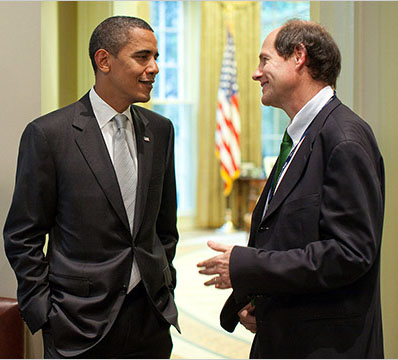Industry’s Man in the White House
 Not very many citizens realize the process that proposed environmental regulations have to go through in any administration in order to get out and published in he Federal Register in one piece. Not only does the regulation have to pass through the EPA's own cost-benefit analysis and survive various Congressional and court challenges, it must also pass through a murkier and more subjective test administered by the Office of Management and Budget, or OMB.
Not very many citizens realize the process that proposed environmental regulations have to go through in any administration in order to get out and published in he Federal Register in one piece. Not only does the regulation have to pass through the EPA's own cost-benefit analysis and survive various Congressional and court challenges, it must also pass through a murkier and more subjective test administered by the Office of Management and Budget, or OMB.
OMB is the very last stop an environmental regulation makes. There are no environmental scientists at OMB to judge the necessity of the regulation. No, OMB's job is to make sure the regulation doesn't hurt industry too much. That may seem like a worthwhile goal, but without any kind of strict guidelines for how to judge that, the conclusion is often open to a lot of interpretation. Industry knows that OMB is its last shot at stopping a regulation that otherwise has broad support form the public and even EPA. Among the non-profit environmental activists in DC, OMB is known as the place regulation go to die.
That's how last year's decision to leave the new ozone standard at 75 parts per billion, rather than the 70 ppb that EPA scientists had advocated – got done. Same thing for a weaker Particulate Matter standard this year. And we can't prove it yet, but we bet OMB had something to do with the rollback in cement plant emission rules being proposed suddenly by EPA/.
The face of the Obama Administration's OMB has been Cass Sunstein, head of the OMB's Office of Information and Regulatory Affairs (OIRA), a powerful department that holds sway over federal agency rulemakings. Having done his damage in the first Obama Administration, he recently announced he was leaving his job and returning to academia. But not before the DC publication "The Hill" got its hands on the e-mails Sunstein sent on behalf of the US Chamber of Commerce to get last year's ozone pollution standard weakened. In effect, he becomes a lobbyist on behalf of industry within the administration after industry has already lost the public health debate.
"The response to The Hill’s FOIA request shows Sunstein played an active role in alerting White House aides to business’s concerns about tightening the ozone standards. Internal communications show that ahead of the September decision, Sunstein circulated strong criticism of the ozone rule from a pair of powerful business groups, the National Association of Manufacturers (NAM) and the Business Roundtable, as well as House lawmakers opposing the tougher standards."
On July 15 of last year, Sunstein sent DeParle and two other aides a copy of a letter from the Business Roundtable to Daley, saying it was “worth reading.” The business group also released the letter publicly at the time.
On July 26, Sunstein sent a wider group of aides — including senior energy adviser Zichal and Phil Schiliro — a column titled “The Latest Job Killer From the EPA” that Business Roundtable President John Engler penned in The Wall Street Journal.
An un-redacted portion of the message from Sunstein states, “I am sure you saw this but just in case.
On Wednesday, Aug. 31, Sunstein forwarded several aides — including Stephanie Cutter, now a top Obama campaign official — an op-ed that NAM President and CEO Jay Timmons penned in The Hill attacking the ozone rule."
